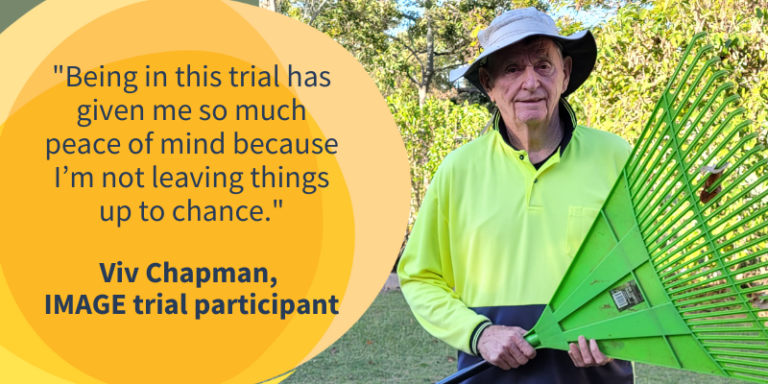As a retired primary school teacher, Vivian (or Viv as he’s known to his friends) has spent most of his adult life passing on valuable knowledge to his students. But it was a visit to his doctor that provided him with an unexpected – and lifesaving – lesson.
Having enjoyed an active upbringing in Queensland’s sugarcane country, Viv – now 76 – was well aware of his increased risk for skin cancer.
Over his many years of teaching, Viv had drilled the mantra “no hat, no play” into hundreds of students and led by example, always making sure to wear a large hat and sunscreen while on yard duty.
Yet despite his vigilance, Viv had never given too much thought to the small brown mark on his chest.
“It looked like a tiny smudge – almost like a bit of dirt that I just couldn’t clean off. After 10 years of being there it just became another part of my body that I never paid any attention to, like the countless other freckles, bumps and blemishes I’ve collected over the years,” Viv said.
But while Viv didn’t pay any attention to the seemingly innocent mark, his doctor did and during a routine visit recommended Viv see a dermatologist for a skin check.
After making the 90-minute drive from his home in regional Queensland to Townsville, Viv underwent a full body scan. The results confirmed what his doctor had suspected. The small, seemingly innocuous smear was a melanoma.

“I’d ignored the thing for years and would have kept doing so right until it was too late. But thanks to the full body scan and my observant specialist, I was able to get the melanoma removed before it spread,” Viv said.
While Viv was indeed lucky, he was also acutely aware of the potential for more melanomas to appear, particularly given how many spots the scan identified – 1,735 to be precise.
Not wanting to tempt fate, Viv enrolled in the IMAGE clinical trial, which is one of the trials coordinated by Melanoma and Skin Cancer Trials (MASC Trials).
The IMAGE trial is exploring whether regular full body photography can help reduce the number of ‘just in case’ biopsies following a melanoma diagnosis and improve patient outcomes. The trial will help to determine whether this surveillance photography, which typically costs around $450, should be covered by Medicare.
“I joke with my wife that I’m a supermodel because I’ve posed for photographs in my underwear – although my photoshoots are much quicker and easier. It’s all done in about 30 minutes, after which we can see how every single spot on my body is tracking and whether any have grown.”
“Being in this trial has given me so much peace of mind because I’m not leaving things up to chance or hoping someone happens to notice a small change in one of the many marks on my body,” he said.
While he formally left the classroom over 20 years ago, Viv has one important lesson he passes on at every opportunity.
“Go and get those spots checked. Everyone thinks it’s not going to happen to them, or they’ll get around to getting a skin check eventually, but melanoma can happen to anyone. So don’t put off a skin check – make the most of the incredible medical resources we have in this country and get your skin checked!”
To learn more about the IMAGE clinical trial and how it’s helping people like Viv to monitor their skin with confidence, visit the IMAGE trial web page.

